
|
Khingila is the first of the four kings mentioned on the Schøyen copper scroll inscription and therefore may have been the eldest or
seniormost among them.
Traditionally, Khingila is regarded as the Alchon king who started to make serious inroads into India, but there is no definitive evidence of this ... it is just
that he was one of the few kings whose name could be read on the coins. Göbl thought Khingila was Toramana's father, which we now know from
the copper scroll is almost certainly not true. Had there been any relationship between them, the scroll would surely have mentioned this, as a number of
other familial relationships are documented in it. Also, Göbl assigned many coin types to Khingila, but this was more a reflection of his inability to
definitively assign them to anyone else. Nevertheless, the earliest Khingila coins seem very close to the early anonymous types seen on the last page and,
combining this with Khingila's primary position in the copper scroll list, it seems reasonable to list his coins first. Perhaps his rule did start first and perhaps
he did make some conquests in Gandhara.
In what follows below, I provide listings of coins that are definitvely Khingila's and then list some coins that seem to follow his stylistically. This would
form the first of the four sequences of coins stemming from the early anonymous types of the previous page.
|
 |
Khingila |
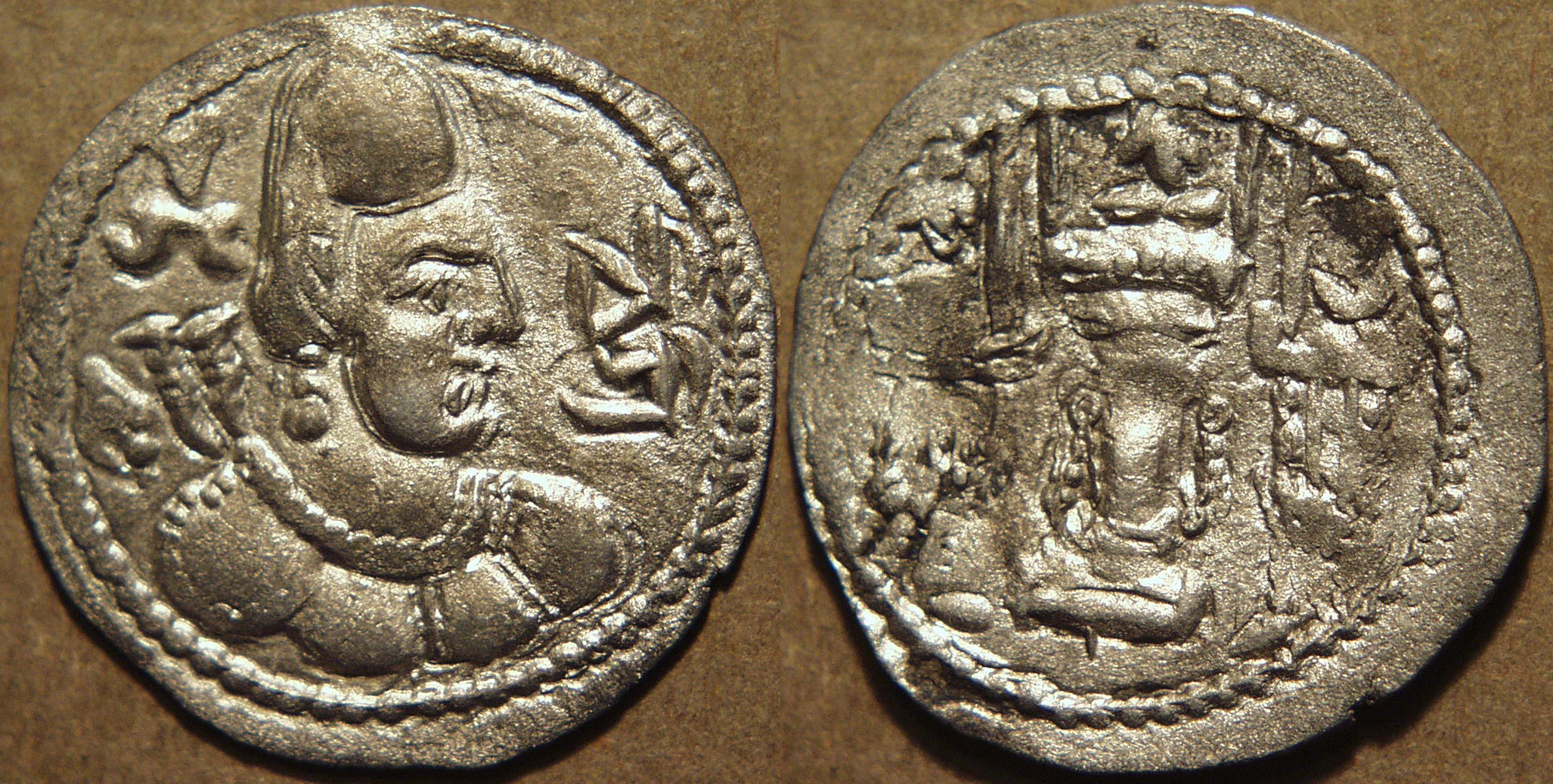
|
Khingila silver drachm, c. mid-5th century
Bare-headed bust of king right, "bull" tamgha at left,
Bactrian legend at right: khigi /
Fire altar, flanked by armed attendants
Weight: 3.45 gm, Diameter: 25 mm., Die axis: 3 o'clock
Ref: Göbl 57
|
 |
The earliest Khingila coins follow directly from the anonymous types with the separated ribbon
ends attached to the necklace. The differences are (1) that the bull/lunar tamgha has migrated from the right to the left (replacing the crescent, thereby suggesting
that the "bull" tamgha may be a misnomer ... perhaps it should be seen as a crescent tamgha), and (2) the space previously occupied at right by the tamgha
now carries a Brahmi legend that reads khigi (for Khingila). A further difference occurs on the reverse: here, instead of the flames seen emerging from the
fire altar in previous coin types, a bust, normally thought to be that of Ahura Mazda, is seen emerging from the top of the altar.
|
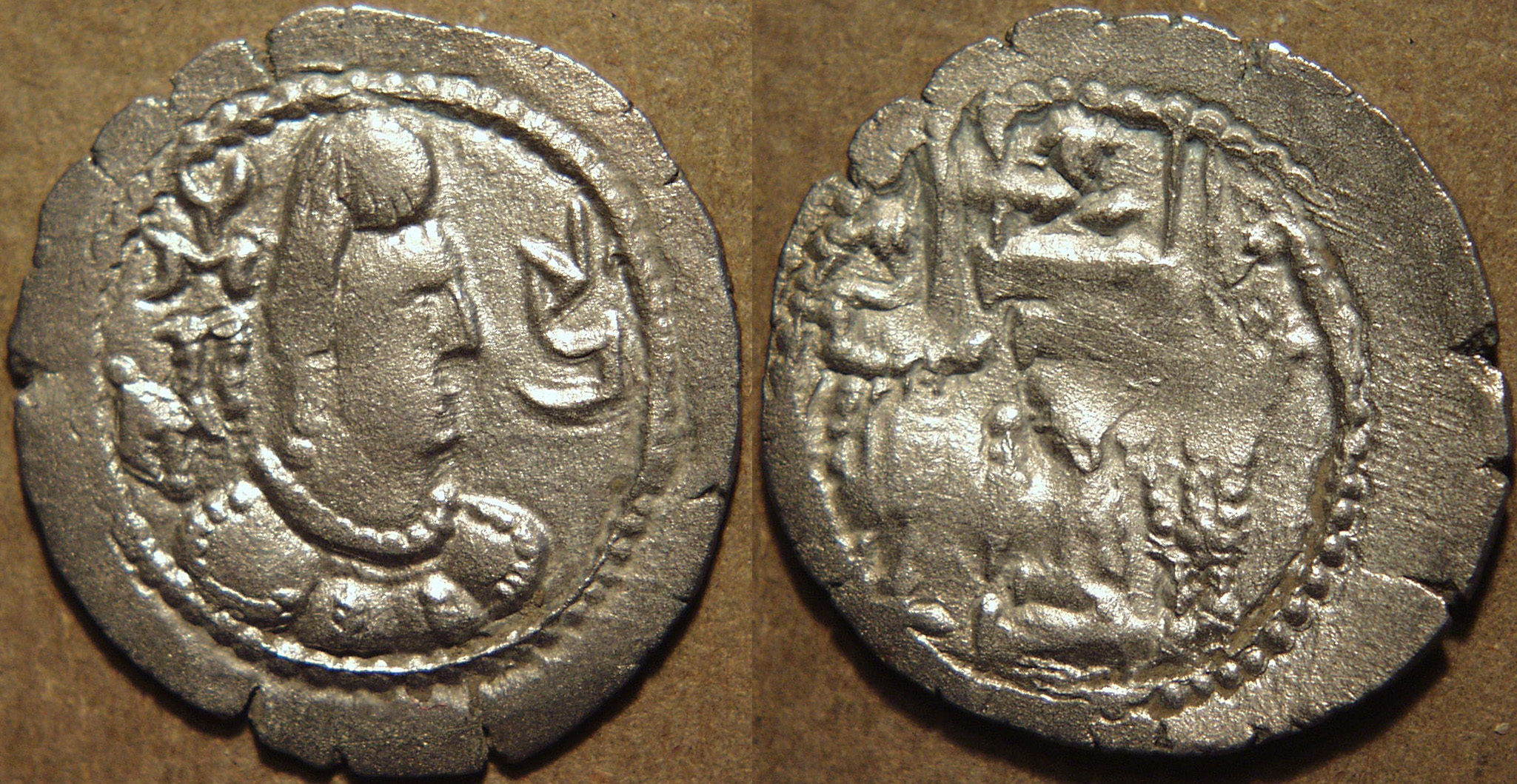
|
Khingila silver drachm, c. mid-5th century
Bare-headed bust of king right, "bull" tamgha at left,
Bactrian legend at right: khaga /
Fire altar, flanked by armed attendants
Weight: 3.46 gm, Diameter: 24.5 mm., Die axis: 3 o'clock
Ref: Göbl 57
|
 |
The celator left out the vowel diacritics on this example, rendering the name khaga instead of
khigi (for Khingila).
|
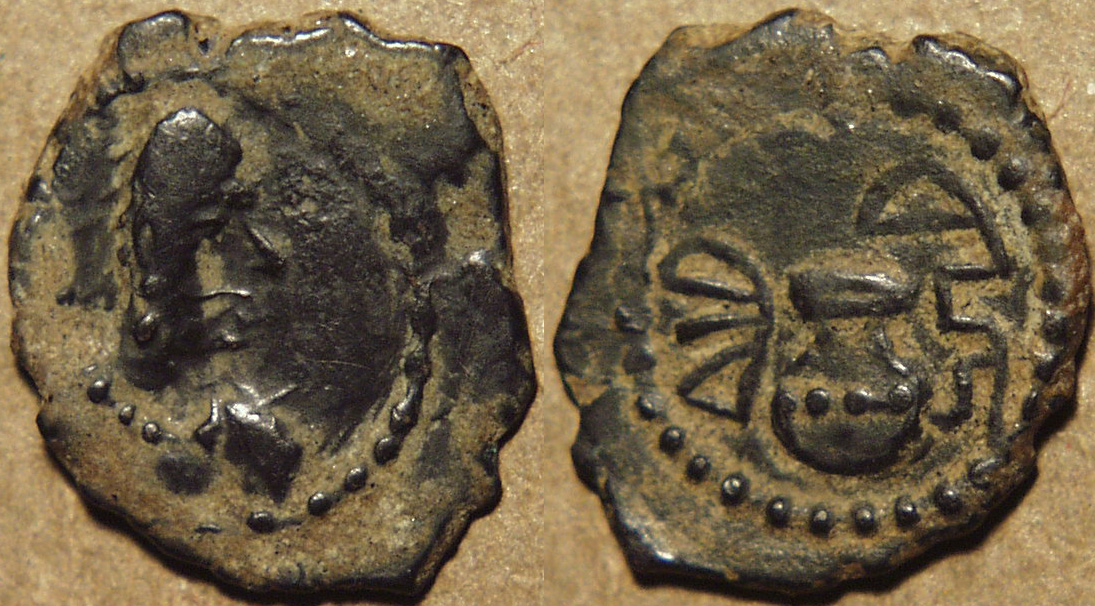
|
Khingila copper unit, c. mid-5th century
Bare-headed bust of king right,
Bactrian legend at right: khaga /
Saced vase (kalasha), flanked by Brahmi legend: khi / ngi
Weight: 1.22 gm, Diameter: 13-14 mm., Die axis: 12 o'clock
Ref: Göbl 54
|
 |
As in the case of the anonymous coins, Khingila issued small copper coins that had well-executed
(not obliterated) reverses at a 12 o'clock die axis, rather than the 3 o'clock die axes on all the silver coins.
|

|
Khingila silver drachm, c. mid-5th century
Crowned bust of king right, with crescent forehead ornament and hanging ribbon ends
"fly-whisk" shoulder ornaments, "bull" tamgha at right,
Bactrian legend above: left: khiggilo, right: alchono /
Fire altar, flanked by armed attendants
Weight: 3.66 gm, Diameter: 30 mm., Die axis: 3 o'clock
Ref: Göbl 61
|
 |
A magnificent coin type with a beautiful, bold portrait and a number of innovations. The most
important one is that the king is now crowned: he wears a diadem with hanging ribbon ends and a crescent forehead ornament. There are no
ribbons attached to the necklace any more. The bull tamgha has made its way back to the right to accommodate the hanging ribbons in the left field.
The king's name is now rendered in Bactrian: khiggilo (not very visible on this specimen because of the flatness between 9 and 11 o'clock).
The Bactrian legend alchono has also made its way back ... here from 1 to 5 o'clock. Finally, a strange aspect is the appearance of the
"fly-whisk" shoulder ornaments. We don't know their significance ... one theory is that they represent divinity in the way it was often represented by
shoulder flames on Kushan coins. The reverse once again has flames emanating from the fire altar.
|
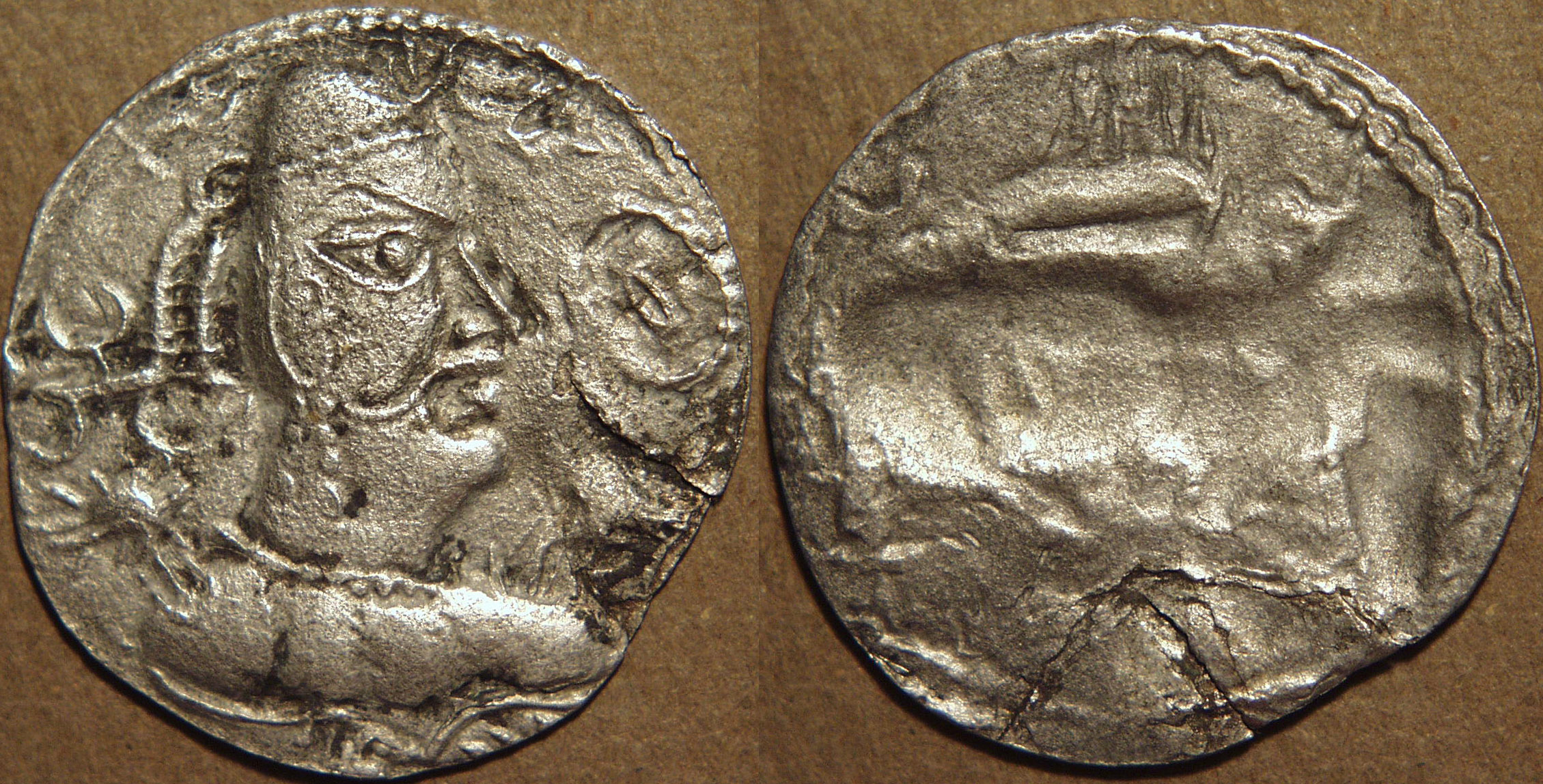
|
Khingila ? silver drachm, c. mid-5th century
Crowned bust of king right, with crescent forehead ornament and hanging ribbon ends
"fly-whisk" shoulder ornaments, "bull" tamgha at left, solar disc at right,
Bactrian legend above: left: ???, right: alchono /
Fire altar, flanked by armed attendants
Weight: 2.80 gm, Diameter: 27 mm., Die axis: 3 o'clock
Ref: Göbl 70
|
 |
The attribution of this coin is uncertain ... Göbl read the legend at left as a retrograde
shoyo and suggested an attribution to Khingila, but he attributed almost all problematic Alchon coins to that king. Nevertheless, it seems to me
the coin is probably an issue of Khingila as it is clearly related to the previous coin and also to the next coin, previously unpublished, that does seem to
have been issued by Khingila.
|
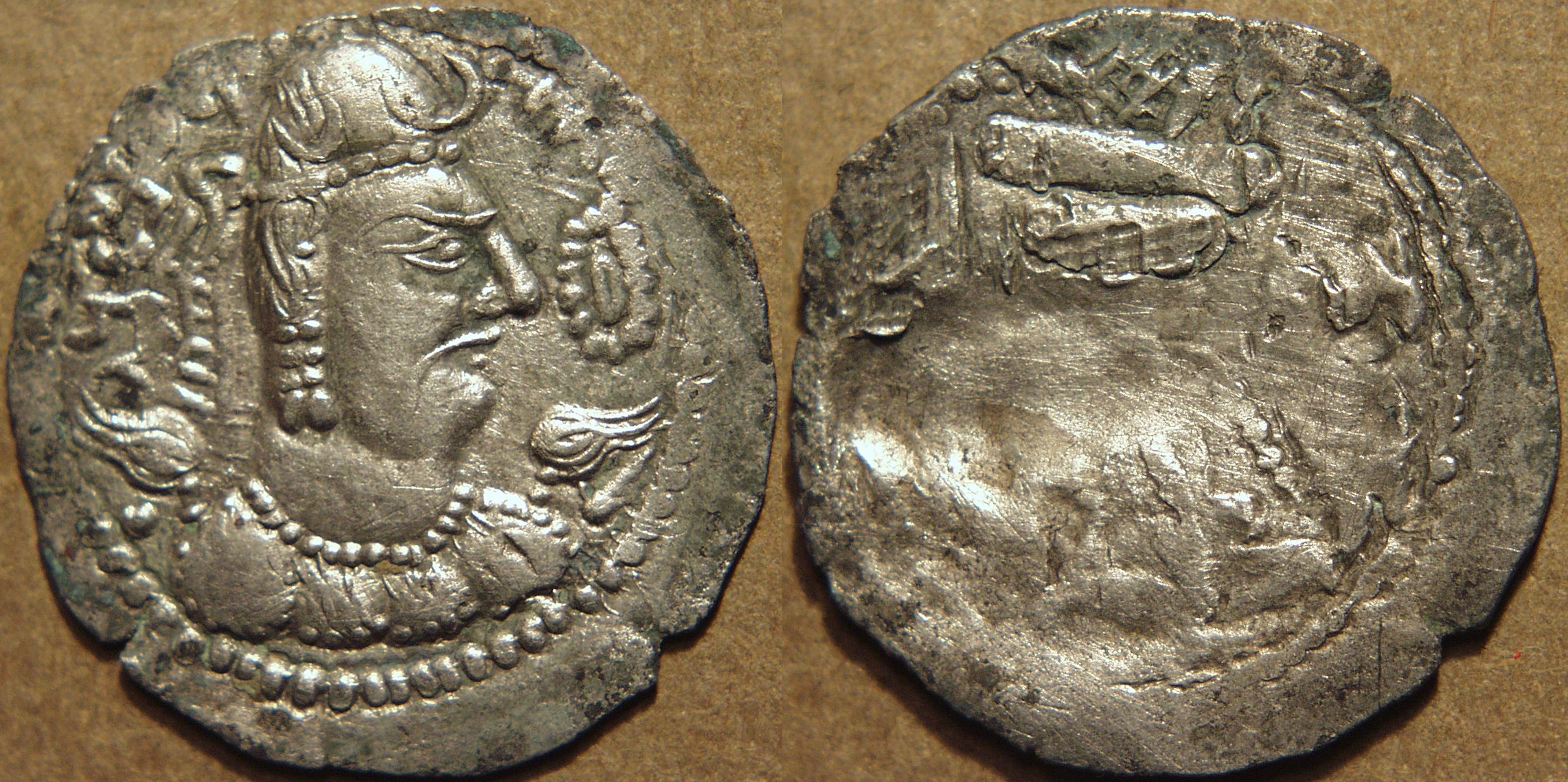
|
Khingila ? silver drachm, c. mid-5th century
Crowned bust of king right, with crescent forehead ornament and hanging ribbon ends
"fly-whisk" shoulder ornaments, "bull" tamgha at left, solar disc at right,
Brahmi legend at left: khinkila, Bactrian at right: alchono /
Fire altar, flanked by armed attendants
Weight: 3.51 gm, Diameter: 28 mm., Die axis: 3 o'clock
Ref: Göbl --- (unpublished variant of G 70)
|
 |
This coin, previously unpublished, appears to be an evolution from the previous one. The style is
finer, but it retains the previous coin's fly-whisk shoulder ornaments, the bull/lunar tamgha at left, the solar disc at right, and the Bactrian legend
alchono at top right. However, it inserts a Brahmi legend at top left that is somewhat difficult to read, but I believe reads khinkila. This is a
known variant spelling of Khingila's name. This coin and the previous one form a "bridge" between the previous coin and the next coin, both
of which are definitvely Khingila issues.Specifically, they retain the "fly-whisk" ornaments of the previous coin (not seen on coins definitively assigned to any
ruler other than Khingila), but introduce the solar disc in the right field, which is seen on the next coin. Stylistically, this coin has a close affinity to
the next coin.
|
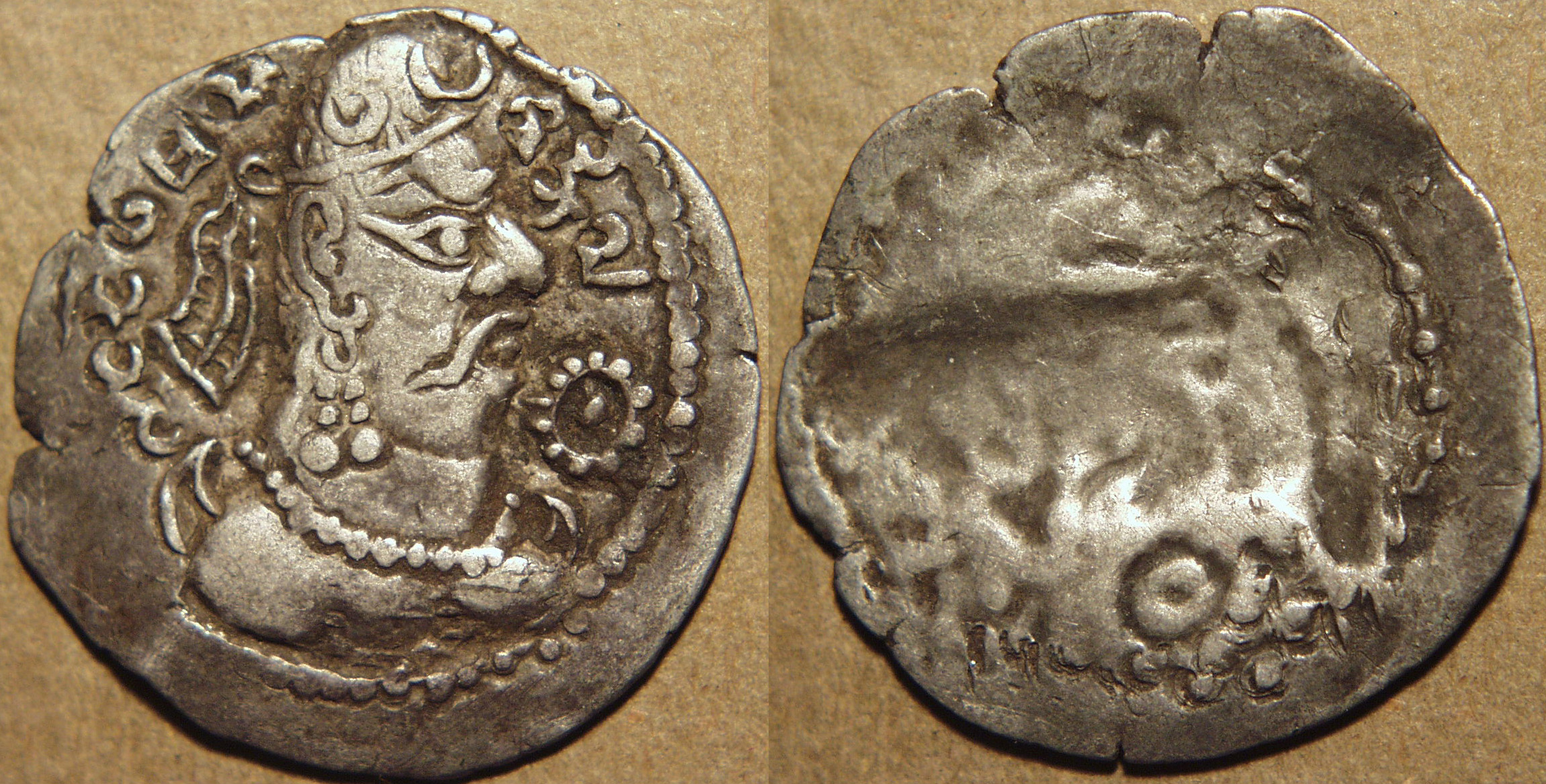
|
Khingila silver drachm, c. mid-5th century
Crowned bust of king right, with crescent forehead ornament and hanging ribbon ends
lunar crescents on shoulders, "bull" tamgha at left, solar disc at right,
Brahmi legend above: left: devashahi, right: khingila /
Fire altar, flanked by armed attendants
Weight: 3.59 gm, Diameter: 28 mm., Die axis: ? o'clock
Ref: Göbl 81
|
 |
Khingila's "final" issues evolve from the previous coin. They retain the tamgha at left and solar disc
at right and the crescented diadem with the hanging ribbons, but then introduce a couple of significant changes. First, the "fly-whisk" shoulder ornaments
are replaced by lunar crescents, probably to still emphasize the king's divinity, and the legend is now in Brahmi: devashahi khingila.
|
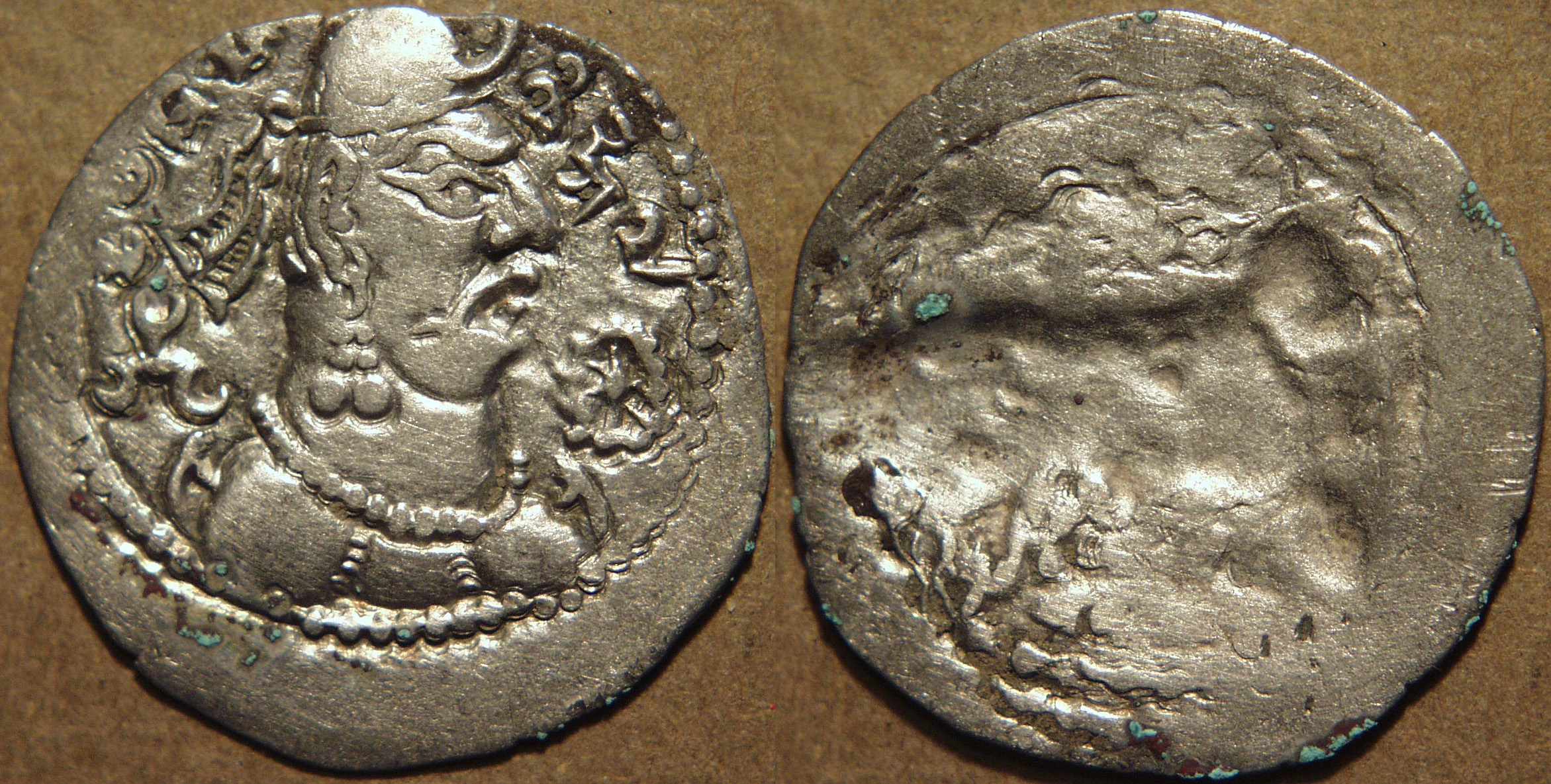
|
Khingila silver drachm, c. mid-5th century
Crowned bust of king right, with crescent forehead ornament and hanging ribbon ends
lunar crescents on shoulders, "bull" tamgha at left, solar disc at right,
Brahmi legend above: left: devashahi, right: khingila /
Fire altar, flanked by armed attendants
Weight: 3.73 gm, Diameter: 28 mm., Die axis: ? o'clock
Ref: Göbl 81
|
 |
Another example of the previous type.
|
 |
 |
 |
"Raja Lakhana" |

|
"Raja Lakhana" silver drachm, c. late-5th century
Crowned bust of king right, with crescent forehead ornament and hanging ribbon ends
lunar crescents on shoulders, "bull" tamgha at left, trident at right,
Bactrian legend above left: alchono, Brahmi legend above right: raja lakhana /
Fire altar, flanked by armed attendants
Weight: 3.67 gm, Diameter: 28 mm., Die axis: 3 o'clock
Ref: Göbl 80
|
 |
Stylistically, this coin type seems to be related to the late Khingila drachms, with
a trident replacing the solar disc in the right field. Here though there are both a Bactrian legend (alchono) and a Brahmi legend
raja lakhana, which seem to be translations of one another and just represent a title. The king may be Udayaditya, whose coins
are shown next. The coin forms a bridge between the previous coins of Khingila and those of Udayaditya. Like the Khingila coins, it
features the bull/lunar tamgha at left, lunar crescents on the shoulders, and an additional symbol (trident instead of the solar disc) at right.
But it introduces the title subsequently used by Udayaditya.
|
 |
 |
 |
Udayaditya |
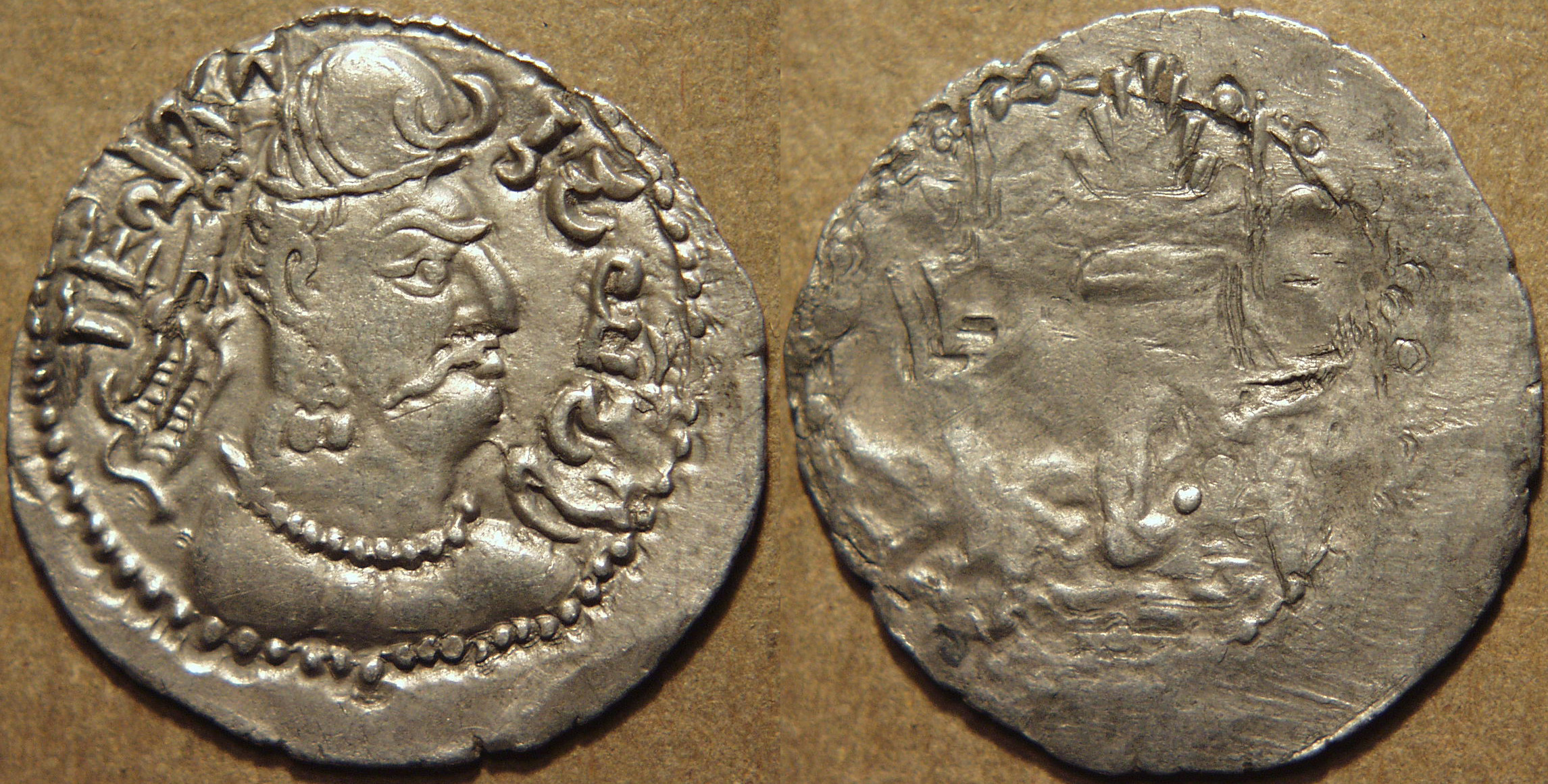
|
Udayaditya silver drachm, c. late-5th century or early 6th century
Crowned bust of king right, with crescent forehead ornament and hanging ribbon ends
Brahmi legend above, left: raja lakhana, right: udayaditya /
Fire altar, flanked by armed attendants
Weight: 3.63 gm, Diameter: 28 mm., Die axis: 3 o'clock
Ref: Göbl 79
|
 |
On this coin, we have a name: Udayaditya, and his title: raja lakhana,.
which connects this coin to the previous one. However, the trident and, surprisingly, the tamgha, from the previous type have
disappeared ... there are no symbols, not even the lunar shoulder crescents. All of the open space on the coin have been given
over to the title and name. But this type appears to follow in the Khingila series.
|

|
Udayaditya silver drachm, c. late-5th century or early 6th century
Crowned bust of king right, with crescent forehead ornament and hanging ribbon ends
Brahmi legend above, left: raja lakhana, right: udayaditya /
Fire altar, flanked by armed attendants
Weight: 3.68 gm, Diameter: 28 mm., Die axis: 3 o'clock
Ref: Göbl 79
|
 |
This example has quite a distinct portrait.
|

|
Udayaditya silver drachm, c. late-5th century or early 6th century
Crowned bust of king right, with crescent forehead ornament and hanging ribbon ends
Brahmi legend above, left: raja lakhana, right: udayaditya /
Fire altar, flanked by armed attendants
Weight: 3.79 gm, Diameter: 26 mm., Die axis: 3 o'clock
Ref: Göbl 79
|
 |
Yet another portrait style, very similar to that on the next coin.
|
 |
 |
 |
"Shahi Javuvla" |
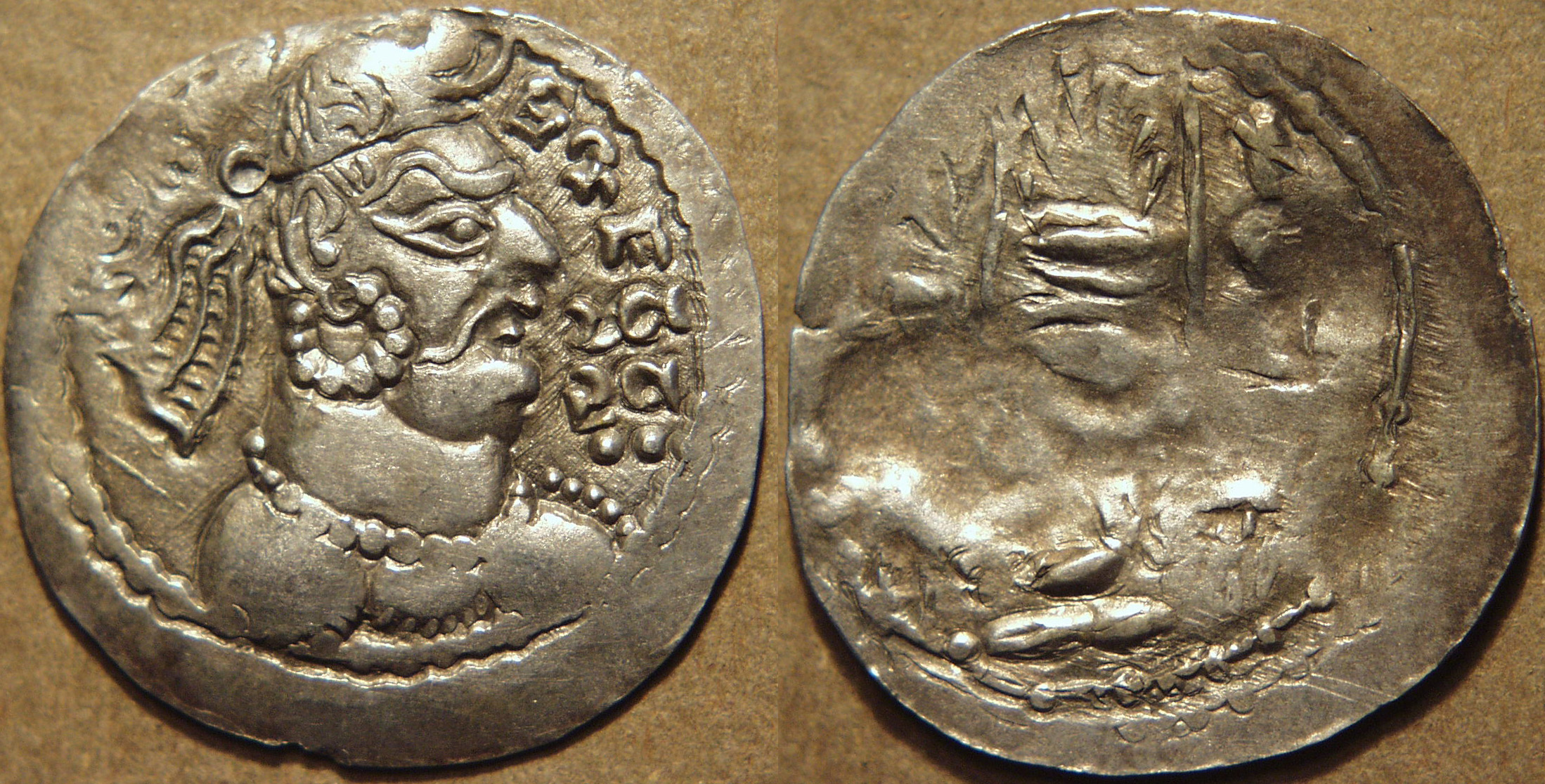
|
"Shahi Javuvla" silver drachm, c. late-5th century or early 6th century
Crowned bust of king right, with crescent forehead ornament and hanging ribbon ends
Brahmi legend above, left: jayatu, right: shahi javuvlah /
Fire altar, flanked by armed attendants
Weight: 3.52 gm, Diameter: 27 mm., Die axis: 3 o'clock
Ref: Göbl 82
|
 |
Vondrovec has assigned this coin to Javukha, but without any justification or
explanation that I could find. Stylistically, it has absolutely nothing in common with the known coins of Javukha. Rather, it seems to follow
closely the coins of Udayaditya. Initially, I was tempted to attribute this to Toramana for two reasons. First, the coin uses the word jayatu,
which was also used on Toramana's and Mihirakula's coins. Second, in the Kura inscription, Toramana is referred to as mahararaja-toramana-
shahi-jauvla. For both these reasons, an attribution to Toramana seems plausible. Indeed, P.L. Gupta, in his book Coins does assign
this coin to Toramana, again without any explanation. However, the coin is stylistically
so similar to the Udayaditya coins, it seems more reasonable to assign it to a king following Udayaditya, perhaps Udayaditya himself. The word
jauvla or javuvla seems to be a title and another king could well have adopted it, as they could have adopted the use of the word
jayatu. Overall, the attribution of this coin is an open question. One other interesting aspect of this coin worth pointing out is the prominent
hoop ear-ring ... the only Hun coin type to feature this, rather than the usual double drop ear-rings.
|
|
|